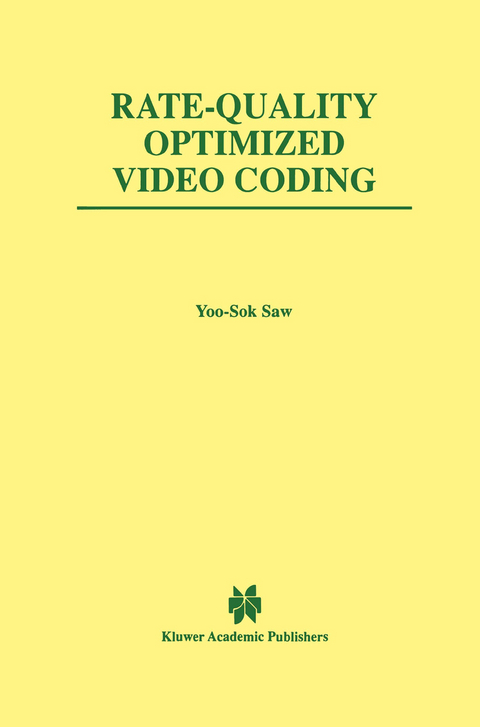
Rate-Quality Optimized Video Coding
Seiten
1998
Springer (Verlag)
978-0-7923-8376-5 (ISBN)
Springer (Verlag)
978-0-7923-8376-5 (ISBN)
Rate-Quality Optimized Video Coding discusses the matter of optimizing (or negotiating) the data rate of compressed digital video and its quality, which has been a relatively neglected topic in either side of image/video coding and tele-traffic management. Video rate management becomes a technically challenging task since it is required to maintain a certain video quality regardless of the availability of transmission or storage media. This is caused by the broadband nature of digital video and inherent algorithmic features of mainstream video compression schemes, e.g. H.261, H.263 and MPEG series. In order to maximize the media utilization and to enhance video quality, the data rate of compressed video should be regulated within a budget of available media resources while maintaining the video quality as high as possible.
In Part I (Chapters 1 to 4) the non-stationarity of digital video is discussed. Since the non-stationary nature is also inherited from algorithmic properties of international video coding standards, which are a combination of statistical coding techniques, the video rate management techniques of these standards are explored. Although there is a series of known video rate control techniques, such as picture rate variation, frame dropping, etc., these techniques do not view the matter as an optimization between rate and quality. From the view of rate-quality optimization, the quantizer is the sole means of controling rate and quality. Thus, quantizers and quantizer control techniques are analyzed, based on the relationship of rate and quality.
In Part II (Chapters 5 and 6), as a coherent approach to non-stationary video, established but still thriving nonlinear techniques are applied to video rate-quality optimization such as artificial neural networks including radical basis function networks, and fuzzy logic-based schemes. Conventional linear techniques are also described before the nonlinear techniques are explored. By using these nonlinear techniques, it is shown how they influence and tackle the rate-quality optimization problem. Finally, in Chapter 7 rate-quality optimization issues are reviewed in emerging video communication applications such as video transcoding and mobile video. This chapter discusses some new issues and prospects of rate and quality control in those technology areas.
Rate-Quality Optimized Video Coding is an excellent reference and can be used for advanced courses on the topic.
In Part I (Chapters 1 to 4) the non-stationarity of digital video is discussed. Since the non-stationary nature is also inherited from algorithmic properties of international video coding standards, which are a combination of statistical coding techniques, the video rate management techniques of these standards are explored. Although there is a series of known video rate control techniques, such as picture rate variation, frame dropping, etc., these techniques do not view the matter as an optimization between rate and quality. From the view of rate-quality optimization, the quantizer is the sole means of controling rate and quality. Thus, quantizers and quantizer control techniques are analyzed, based on the relationship of rate and quality.
In Part II (Chapters 5 and 6), as a coherent approach to non-stationary video, established but still thriving nonlinear techniques are applied to video rate-quality optimization such as artificial neural networks including radical basis function networks, and fuzzy logic-based schemes. Conventional linear techniques are also described before the nonlinear techniques are explored. By using these nonlinear techniques, it is shown how they influence and tackle the rate-quality optimization problem. Finally, in Chapter 7 rate-quality optimization issues are reviewed in emerging video communication applications such as video transcoding and mobile video. This chapter discusses some new issues and prospects of rate and quality control in those technology areas.
Rate-Quality Optimized Video Coding is an excellent reference and can be used for advanced courses on the topic.
I Background of video rate-quality optimisation.- 1. Non-Stationary Nature of Digital Video.- 2. Rate-Quality Control In International Standards.- 3. Quantiser Control For Rate-Quality Optimisation.- 4. Linear Predictive Video Rate Estimation and Control.- II Nonlinear signal processing approaches to video rate-quality optimisation.- 5. Nonlinear Predictive Video Rate Estimation and Control.- 6. Fuzzy Logic-Based Video Rate Estimation and Control.- 7. Advanced Topics.- References.- Appendices A-Video sequences used in simulations.
| Erscheint lt. Verlag | 30.11.1998 |
|---|---|
| Reihe/Serie | The Springer International Series in Engineering and Computer Science ; 486 |
| Zusatzinfo | XXV, 183 p. |
| Verlagsort | Dordrecht |
| Sprache | englisch |
| Maße | 155 x 235 mm |
| Themenwelt | Naturwissenschaften ► Physik / Astronomie ► Mechanik |
| Technik ► Elektrotechnik / Energietechnik | |
| Technik ► Nachrichtentechnik | |
| ISBN-10 | 0-7923-8376-1 / 0792383761 |
| ISBN-13 | 978-0-7923-8376-5 / 9780792383765 |
| Zustand | Neuware |
| Informationen gemäß Produktsicherheitsverordnung (GPSR) | |
| Haben Sie eine Frage zum Produkt? |
Mehr entdecken
aus dem Bereich
aus dem Bereich
Statik - Kinematik - Kinetik - Schwingungen - Festigkeitslehre
Buch | Hardcover (2021)
Hanser, Carl (Verlag)
29,99 €


